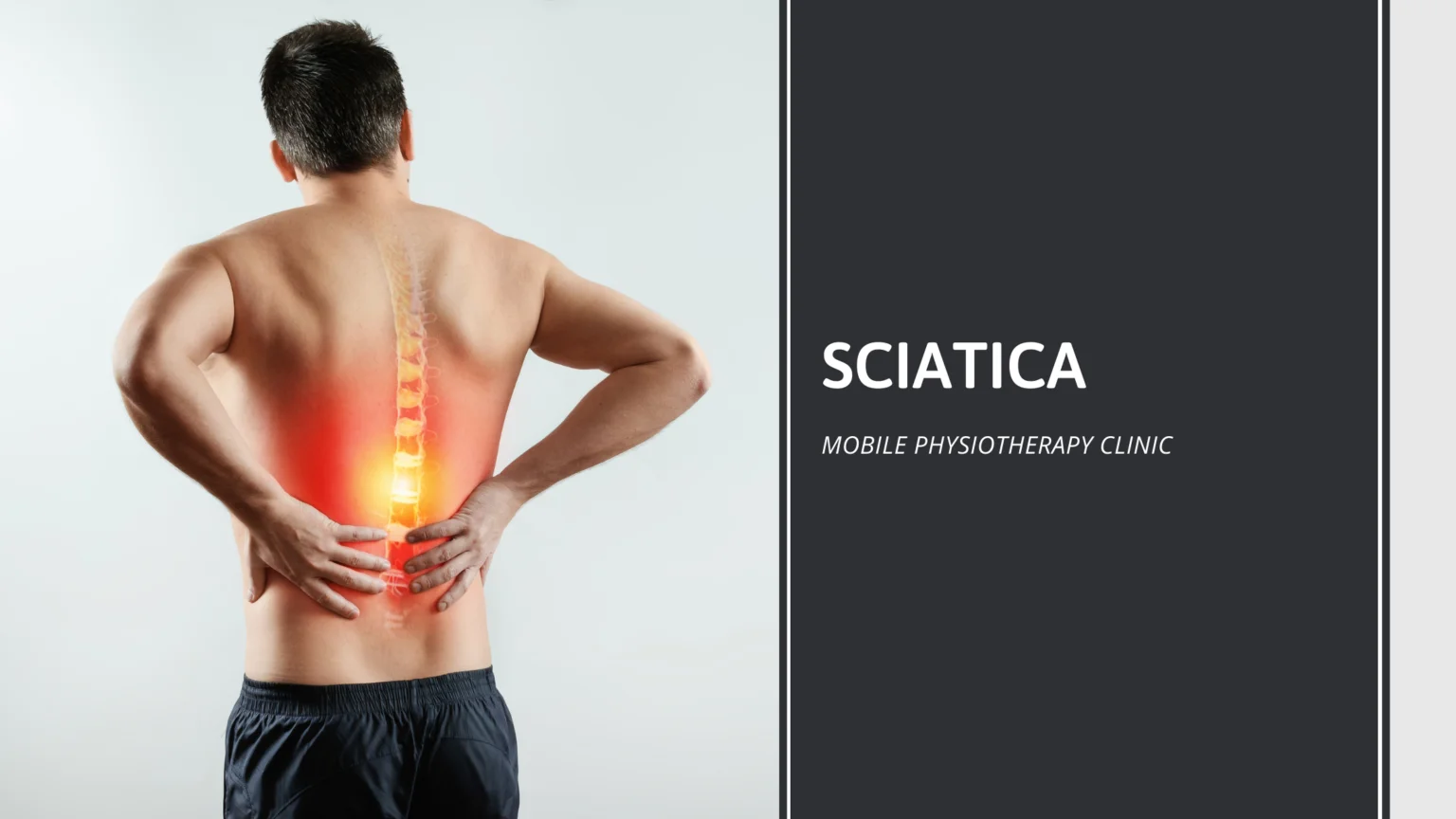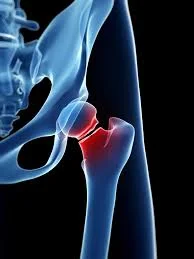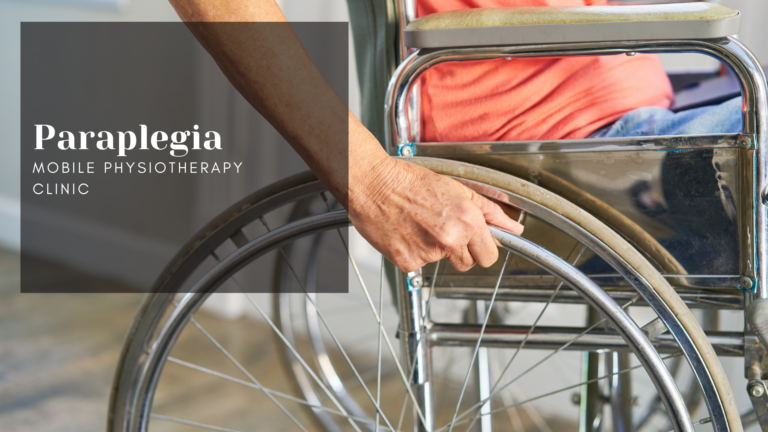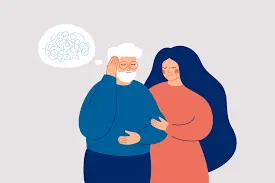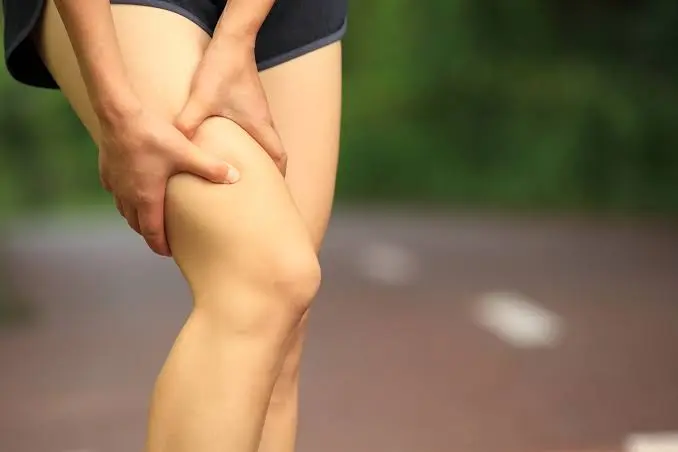Sciatica
Sciatica is nerve pain from an injury or irritation to the sciatic nerve, which originates in your buttock/gluteal area. The sciatic nerve is the longest and thickest (almost finger-width) nerve in the body.
It’s actually made up of five nerve roots: two from the lower back region called the lumbar spine and three from the final section of the spine called the sacrum. The five nerve roots come together to form a right and left sciatic nerve. On each side of your body, one sciatic nerve runs through your hips, buttocks and down a leg, ending just below the knee. The sciatic nerve then branches into other nerves, which continue down your leg and into your foot and toes.
True injury to the sciatic nerve “sciatica” is actually rare, but the term “sciatica” is commonly used to describe any pain that originates in the lower back and radiates down the leg. What this pain shares in common is an injury to a nerve — an irritation, inflammation, pinching or compression of a nerve in your lower back.
If you have “sciatica,” you experience mild to severe pain anywhere along the path of the sciatic nerve – that is, anywhere from the lower back, through the hips, buttocks and/or down your legs. It can also cause muscle weakness in your leg and foot, numbness in your leg, and an unpleasant tingling pins-and-needles sensation in your leg, foot and toes.
People describe sciatica pain in different ways, depending on its cause. Some people describe the pain as sharp, shooting, or jolts of pain. Others describe this pain as “burning,” “electric” or “stabbing.”
The pain may be constant or may come and go. Also, the pain is usually more severe in your leg compared to your lower back. The pain may feel worse if you sit or stand for long periods of time, when you stand up and when you twist your upper body. A forced and sudden body movement, like a cough or sneeze, can also make the pain worse.
Table of Contents
Symptoms of Sciatica
Common symptoms of sciatica include:
- Lower back pain
- Pain in the rear or leg that is worse when sitting
- Hip pain
- Burning or tingling down the leg
- Weakness, numbness, or a hard time moving the leg or foot
- A constant pain on one side of the rear
- A shooting pain that makes it hard to stand up
Sciatica usually affects only one side of the lower body. Often, the pain extends from the lower back all the way through the back of your thigh and down through your leg. Depending on where the sciatic nerve is affected, the pain may also extend to the foot or toes.
For some people, the pain from sciatica can be severe and disabling. For others, the sciatica pain might be infrequent and irritating, but has the potential to get worse.
Seek medical attention right away if you have:
- Fever and back pain
- Swelling or redness in your back or spine
- Pain that moves down your legs
- Numbness or weakness in the upper thighs, legs, pelvis, or bottom
- Burning when you pee or blood in your pee
- Serious pain
- Loss of bladder or bowel control (leaking or not being able to make it to the toilet in time)
Causes of Sciatica
Common causes of sciatica include:
- Lumbar herniated disc: Research suggests that up to 90% of sciatica is caused by a lumbar herniated disc. The herniated disc typically compresses one or more spinal nerve roots (L4-S3) that form the sciatic nerve. A lumbar herniated disc can cause sciatica in two ways:
- Direct compression: Direct compression of the sciatic nerve can occur when a lumbar disc bulges (contained-disc-disorder) or when the soft inner material of the disc leaks out or herniates through the fibrous outer core (non-contained disc disorder) and presses against the nerve.
- Chemical inflammation: An acidic chemical irritant from the disc material (hyaluronan) may leak out and cause inflammation and irritation in the area around the sciatic nerve.
A herniated disc may compress the sciatic nerve on one side, causing symptoms in one leg, or the disc may bulge or herniate from both sides, causing symptoms in both legs (bilateral sciatica). Bilateral sciatica may also be caused by two adjacent segments discs herniating on either side, although this possibility is rare.
2. Degeneration: Degeneration of tissues in the lumbar spine can compress or irritate the sciatic nerve. The Degeneration of the facet joints can also cause the synovial tissue in the joint’s capsule to inflame and increase in bulk. Degeneration of vertebral bone may cause abnormal bone growths (bone spurs or osteophytes). These abnormally bulky tissues in the lumbar spine may cause compression of one or more nerve roots of the sciatic nerve. Degenerated intervertebral discs may secrete inflammatory proteins, causing inflammation of the sciatic nerve.
3. Lumbar spinal stenosis: Spinal stenosis is the narrowing of the spinal canal and is relatively common in adults older than age 60. Research suggests that lateral recess stenosis may be common in causing sciatica in the elderly population.
4. Spondylolisthesis: Spondylolisthesis occurs when a small stress fracture causes one vertebral body to slip forward on another. For example, the L5 vertebra may slip forward over the S1 vertebra. Sciatica may result from nerve compression following the disc space collapse, fracture, and forward slipping of the vertebral body. Spondylolisthesis may cause bilateral sciatica and is more common in younger adults.
These conditions may develop over time or spontaneously due to trauma or physical stress injury. Motor vehicle accidents, sports injuries, or falls may cause direct injury to the sciatic nerve. Conditions such as spondylolisthesis and herniated discs may develop from physical stress injuries, such as from weightlifting.
Risk Factors of Sciatica
You are at greater risk of sciatica if you:
- Have an injury/previous injury: An injury to your lower back or spine puts you at greater risk for sciatica
- Age: With normal aging comes a natural wearing down of bone tissue and disks in your spine. Normal aging can put your nerves at risk of being injured or pinched by the changes and shifts in bone, disks and ligaments
- Overweight: Your spine is like a vertical crane. Your muscles are the counterweights. The weight you carry in the front of your body is what your spine (crane) has to lift. The more weight you have, the more your back muscles (counterweights) have to work. This can lead to back strains, pains and other back issues
- Lack a strong core: Your “core” are the muscles of your back and abdomen. The stronger your core, the more support you’ll have for your lower back. Unlike your chest area, where your rib cage provides support, the only support for your lower back is your muscles
- Have an active, physical job: Jobs that require heavy lifting may increase your risk of low back problems and use of your back, or jobs with prolonged sitting may increase your risk of low back problems
- Lack proper posture in the weight room: Even if you are physically fit and active, you can still be prone to sciatica if you don’t follow proper body form during weight lifting or other strength training exercises
- Have diabetes: Diabetes increases your chance of nerve damage, which increases your chance of sciatica
- Have osteoarthritis: Osteoarthritis can cause damage to your spine and put nerves at risk of injury
- Lead an inactive lifestyle: Sitting for a long period of time and not exercising and keeping your muscles moving, flexible and toned can increase your risk of sciatica
- Smoke: The nicotine in tobacco can damage spinal tissue, weaken bones, and speed the wearing down of vertebral disks
Preventions of Sciatica
Prevention is always the best course of action. According to the specialists, the best strategies for preventing sciatica include:
- Exercise: Exercising tops the list of prevention measures because it strengthens the abdomen and back muscles that support the spine. Numerous types of exercises are beneficial, including walking, swimming, Pilates and yoga. In particular, do core exercises and lower back exercises to reduce the chances of developing a herniated disk
- Learn and practice proper lifting techniques: All too often, people improperly lift objects. It is not just the weight of something that leads to herniated disks. They put most of the pressure on their back during lifting when it’s the hips and legs that should be taking the brunt of the weight. It is important to keep the back straight while rising up with the hips and legs. If the item is too heavy to lift while using the right technique, find another way to move the item
- Maintain good posture when sitting: Many people today sit for long periods of time and have poor posture while sitting. This doubles the impact on the spine, especially the lower back. When sitting or standing, keep your back straight and shoulders back to relieve the pressure on the back. Another good practice is to stand up and move around every 30 minutes when a job requires a lot of sitting
- Do not smoke: The negative effects of smoking are many, and include contributing to disk degeneration
Sciatic develops for different reasons, and one is age-related degeneration. Developing a healthy lifestyle is the best way to prevent painful conditions that make it impossible to fully enjoy life.
Diagnosis of Sciatica
During the physical exam, your doctor may check your muscle strength and reflexes. For example, you may be asked to walk on your toes or heels, rise from a squatting position and, while lying on your back, lift your legs one at a time. Pain that results from sciatica will usually worsen during these activities.
Imaging tests
Many people have herniated disks or bone spurs that will show up on X-rays and other imaging tests but have no symptoms. So doctors don’t typically order these tests unless your pain is severe, or it doesn’t improve within a few weeks.
- X-ray: An X-ray of your spine may reveal an overgrowth of bone (bone spur) that may be pressing on a nerve
- MRI: This procedure uses a powerful magnet and radio waves to produce cross-sectional images of your back. An MRI produces detailed images of bone and soft tissues such as herniated disks. During the test, you lie on a table that moves into the MRI machine
- CT scan: When a CT is used to image the spine, you may have a contrast dye injected into your spinal canal before the X-rays are taken — a procedure called a CT myelogram. The dye then circulates around your spinal cord and spinal nerves, which appear white on the scan
- Electromyography (EMG): This test measures the electrical impulses produced by the nerves and the responses of your muscles. This test can confirm nerve compression caused by herniated disks or narrowing of your spinal canal (spinal stenosis)
Treatment of Sciatica
Upon first diagnosis of sciatica, your doctor will likely give you tips for treating your sciatica pain. You should continue your daily activities as much as possible. Lying in bed or avoiding activity can worsen your condition.
Some commonly suggested at-home treatments are described below.
Cold
You can purchase ice packs or even use a package of frozen vegetables.
Wrap the ice pack or frozen vegetables in a towel and apply it to the affected area for 20 minutes per day, several times per day, during the first few days of pain. This will help to reduce swelling and ease pain.
Hot
You can also purchase hot packs or a heating pad.
It’s recommended that you use ice during the first couple of days to reduce swelling. After two or three days, switch to heat. If you continue to have pain, try alternating between ice and heat therapy.
Stretching
Gently stretching your lower back can also be helpful. To learn how to stretch properly, get personal, one-on-one physical therapy or even yoga instruction from a physical therapist or instructor trained to deal with your injury.
Over-the-counter medication
Over-the-counter medications, such as aspirin and ibuprofen, can also help with pain, inflammation, and swelling. Be careful about using aspirin excessively, since it can cause complications, such as stomach bleeding and ulcers.
Regular exercise
The more you stay active, the more endorphins your body releases. Endorphins are pain relievers made by your body. Stick to low-impact activities at first, such as swimming and stationary bicycling.
As your pain decreases and your endurance improves, create an exercise regimen that includes aerobics, core stability, and strength training. A regimen with these components can decrease your risk of future back problems.
Physical therapy
Exercises in physical therapy can help to improve your posture and strengthen your back muscles.
Prescription medication
Your doctor might prescribe muscle relaxers, narcotic pain relief, or antidepressants. Antidepressants can increase your body’s endorphin production.
Epidural steroid medication
Corticosteroid medications are injected into an area called the epidural space, which is the canal that surrounds your spinal cord. Because of side effects, these injections are given on a limited basis.
Surgery
Surgery may be needed for severe pain or situations in which you have lost control of your bowel and bladder or have developed weakness in certain muscle groups of the lower extremity.
The two most common types of surgery are discectomy, in which part of the disk that’s pressing on nerves that make up the sciatic nerve is removed, and microdiscectomy, in which the disk removal is done through a small cut while your doctor uses a microscope.
Alternative treatments
Alternative medicine is growing in popularity. There are a number of alternative remedies for sciatica. These include the following:
- An acupuncturist can insert sterilized needles at key points to affect the flow of energy in your body. This procedure is virtually painless
- A chiropractor can manipulate your spine to achieve maximum spinal mobility
- A trained professional can induce hypnosis, which is intended to put you in a very relaxed, focused state of mind, allowing you to best receive healthy suggestions and instructions. In the case of sciatic pain, the messages might involve pain relief
- A massage therapist can apply motion, pressure, tension, or vibration to your body to relieve pressure and pain
When to seek medical attention
Seek immediate medical attention if you experience the following symptoms:
- Your pain comes after a severe injury or accident
- You have sudden, excruciating pain in your lower back or leg that’s coupled with numbness or muscle weakness in that same leg
- You’re unable to control your bladder or bowels, which are the symptoms of cauda equina syndrome
Exercises for Sciatica
Sometimes, despite everything, people experience what is referred to as a sciatica flare up. It can be due to something like the piriformis, a small hip muscle, becoming tight and pressing on or pinching the sciatic nerve. Flare ups can also be treated with exercises that are specifically designed to relieve the pressure on the nerve.
Good exercises for managing sciatica flare-ups that also serve as exercises to prevent sciatica are activities like stretching exercises for the hips and lower back, and walking. It may be tempting to lie in bed for hours, hoping the pain will subside. The reality is that extended bed rest can contribute to the development of sciatica when back muscles weaken or because the pain associated with sciatica worsens due to the pressure placed on the spine.
Stretches to Relieve Sciatica
1. Sitting spinal stretch
One of the best stretches for sciatica leg pain is the sitting spinal stretch. It addresses spinal compression causing sciatica pain by opening up space between the spine’s vertebrae.
- Sit on the mat or floor and extend your legs extended straight out in front of you while also flexing the feet upward
- Bend your right knee
- Put the right foot flat on the floor next to the left knee on the outside of the joint
- Put your left elbow on the outside of the knee joint which helps with the turning of the body
- Turn the torso and shoulders towards the right
- Hold for up to 30 seconds
- Repeat the exercise three times
- Switch sides and do the set of exercises again
2. Reclining pigeon stretch
Among the common sciatica nerve stretch exercises is the reclining pigeon pose. This is a basic form of a yoga pose, and it works to open up the hips.
- Lie on the back
- Bring the right knee up to create a right angle
- Clasp your hands behind the thigh
- Lift the left leg and position the right ankle on the left knee
- Hold the pose for 10-20 seconds
- Repeat with the other leg
- Do the exercise with each leg three times
3. Back flexion stretch
The back flexion stretch is one of the stretches to relieve sciatica that loosens up muscles in the spine and abdomen with the added benefit of increasing spinal mobility.
- Lie flat on your back
- Raise your knees to the chest while grasping your hands behind the knees (can place one hand behind each knee without grasping)
- Gently pull your knees towards the chest until you feel a stretch in the mid and lower spinal area
- An advanced stretch involves bringing the head forward and shoulders off the ground while pulling the knees toward the chest
- Hold for 5-10 seconds and then return to laying flat on your back
- Repeat the exercise three times
4. Hamstring stretch
Another one of the best sciatica stretches is the hamstring stretch. It can loosen tight hamstring muscles that are causing tension in the pelvis and increasing lower back stress.
- In a standing position facing forward, cross the right foot over the left foot
- Keep the hips and shoulders aligned
- Place hands on the hips
- Bend at the waist over the right leg while keeping the back straight (the more the bend, the deeper the stretch)
- Hold the bend for 20-30 seconds
- Repeat three times
- Repeat the exercise with the other foot and leg
5. Sciatica stretch
Exercises for sciatic leg pain are intended to relieve pressure on the sciatic nerve.
- Lie on your stomach
- Position the elbows under the shoulders while placing the hands flat on the floor
- Place the forearms flat or close to flat on the floor next to the chest area
- Lift the chest to arch the back enough to extend the spine from the neck to the tailbone
- Hold for 30 seconds
- Repeat two times
6. Knee to opposite shoulder
The knee to opposite shoulder is one of the stretches for sciatica that is simple to do and can loosen hip muscles that might be pressing on the sciatic nerve.
- Lie on your back with the legs extended
- Flex the feet so toes are pointing towards the ceiling
- Lift your right leg towards the chest
- Clasp your hands behind the knee
- Gently pull the knee across the body and towards the left shoulder
- Hold the pose for 30 seconds
- Repeat three times
- Do the same repetitions with the left leg and knee
Easing Sciatica Pain While Sleeping
Of course, everyone should get seven to eight hours of sleep each night. As noted, sciatica pain can intensify when in a prone position for an extended length of time because additional pressure is placed on the spine’s disks. People want to know how to prevent sciatica pain while sleeping.
One strategy is to lie flat on the back and bend the knees slightly while keeping the buttocks and heels flat against the bed. Place a pillow under the knees to provide support. Elevating the knees can take some of the pressure off the spine and thus the sciatica nerve.
Other suggestions include:
- Doing gentle stretching exercises right before getting into bed
- Sleeping on a firm mattress
- Soaking in a warm bath before bedtime
- Using over-the-counter pain medications
A medical professional can offer suggestions on how to prevent sciatica pain while sleeping that best fit the patient’s circumstances.

